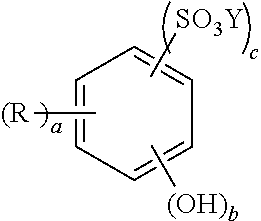Flux method for tin and tin alloys
a flux method and alloy technology, applied in the direction of electrolysis organic material coating, manufacturing tools, solvents, etc., can solve the problems of woodgrain, non-uniform appearance analogous on the surface, and defects in the tin finish during reflow, so as to inhibit acid etching and reduce or prevent woodgrain formation
- Summary
- Abstract
- Description
- Claims
- Application Information
AI Technical Summary
Benefits of technology
Problems solved by technology
Method used
Image
Examples
example 3
[0038]The method described in Example 2 was repeated except that after rinsing the tin plated steel strip was sprayed on both sides with a uniform aqueous flux solution containing 4 g / L 5-sulfosalicylic acid and 120 ppm of EO / PO copolymer with an average molecular weight of 1500 g / mol, and 0.5 ml / L of an sulfated alkyl ethoxylate (TRITON™ QS-15 copolymer surfactant available from The Dow Chemical Company, Midland, Mich.) as the only additives. The top side of the strip (high coating weight) appeared slightly brighter than Example 2 with slightly less haze and the bottom side (light coating weight) was observed to have a slightly less intense woodgrain defect.
example 4
[0039]An addition of 2 g / L sulfuric acid was made to the flux solution from Example 3 and the experiment was repeated. The woodgrain appearance of the bottom side was observed to be significantly reduced in appearance and the brightness of the topside was observed to be improved as well as displaying less haze. The addition of sulfuric acid to the flux solution thus improved brightness, reduced haze and reduced woodgrain on the tin surface.
example 5
[0040]A further addition of 1 g / L sulfuric acid was made to the flux solution from Example 4, now a total of 3 g / L sulfuric acid, and the experiment was repeated. The woodgrain appearance of the bottom side and the brightness of the topside were both observed to be further slightly improved.
PUM
| Property | Measurement | Unit |
|---|---|---|
| current density | aaaaa | aaaaa |
| current density | aaaaa | aaaaa |
| thickness | aaaaa | aaaaa |
Abstract
Description
Claims
Application Information
 Login to View More
Login to View More - R&D
- Intellectual Property
- Life Sciences
- Materials
- Tech Scout
- Unparalleled Data Quality
- Higher Quality Content
- 60% Fewer Hallucinations
Browse by: Latest US Patents, China's latest patents, Technical Efficacy Thesaurus, Application Domain, Technology Topic, Popular Technical Reports.
© 2025 PatSnap. All rights reserved.Legal|Privacy policy|Modern Slavery Act Transparency Statement|Sitemap|About US| Contact US: help@patsnap.com


